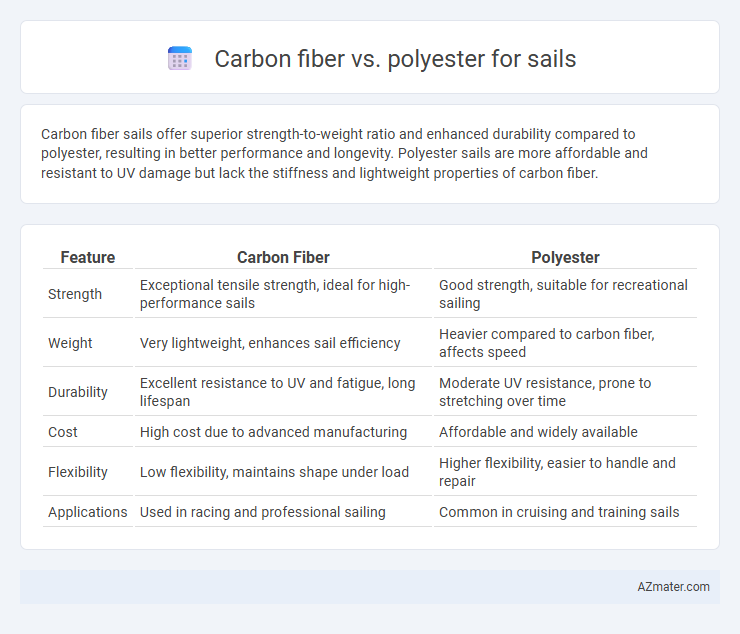Carbon fiber sails offer superior strength-to-weight ratio and enhanced durability compared to polyester, resulting in better performance and longevity. Polyester sails are more affordable and resistant to UV damage but lack the stiffness and lightweight properties of carbon fiber.
Table of Comparison
| Feature | Carbon Fiber | Polyester |
|---|---|---|
| Strength | Exceptional tensile strength, ideal for high-performance sails | Good strength, suitable for recreational sailing |
| Weight | Very lightweight, enhances sail efficiency | Heavier compared to carbon fiber, affects speed |
| Durability | Excellent resistance to UV and fatigue, long lifespan | Moderate UV resistance, prone to stretching over time |
| Cost | High cost due to advanced manufacturing | Affordable and widely available |
| Flexibility | Low flexibility, maintains shape under load | Higher flexibility, easier to handle and repair |
| Applications | Used in racing and professional sailing | Common in cruising and training sails |
Introduction to Carbon Fiber and Polyester in Sailmaking
Carbon fiber offers exceptional strength-to-weight ratio and stiffness, making it ideal for high-performance sails requiring durability and precision. Polyester, known for its affordability and UV resistance, provides reliable flexibility and ease of handling, commonly used in cruising sails. Sailmakers select carbon fiber for competitive racing sails, while polyester suits everyday sailing needs with cost-effectiveness and resilience.
Material Composition and Properties
Carbon fiber sails consist of high-strength carbon filaments woven into a fabric, offering exceptional tensile strength, stiffness, and lightweight properties ideal for high-performance sailing. Polyester sails, composed of polyethylene terephthalate fibers, provide superior UV resistance, durability, and cost-effectiveness, making them a popular choice for cruising and recreational sailing. Carbon fiber's low stretch and high modulus enable precise sail shape retention under load, whereas polyester's moderate stretch aids in forgiving sail handling and longevity under varied marine conditions.
Strength and Durability Comparison
Carbon fiber sails offer superior strength-to-weight ratios compared to polyester, enabling higher performance with less material bulk. The exceptional tensile strength of carbon fiber results in increased durability and resistance to stretching under high wind loads, maintaining optimal sail shape over time. Polyester sails provide decent durability at a more affordable price but tend to experience greater stretch and reduced lifespan under heavy use.
Weight Differences and Performance Impact
Carbon fiber sails provide significantly lower weight compared to polyester, reducing overall rig weight and enhancing boat speed, especially in light wind conditions. The superior stiffness of carbon fiber minimizes sail stretch, maintaining optimal shape and improving performance and upwind efficiency. Polyester sails, although heavier and more prone to deformation, offer cost-effective durability but compromise responsiveness and speed due to increased weight and reduced shape retention.
Flexibility and Sail Shape Retention
Carbon fiber offers superior stiffness and exceptional sail shape retention, maintaining aerodynamic efficiency under high loads, making it ideal for competitive sailing. Polyester, while more flexible and affordable, tends to stretch over time, leading to a loss in sail shape and reduced performance. The choice between carbon fiber and polyester significantly impacts sail longevity and handling, with carbon fiber excelling in firmness and polyester providing greater initial flexibility.
Resistance to Environmental Factors
Carbon fiber sails exhibit superior resistance to UV radiation, saltwater corrosion, and temperature fluctuations compared to polyester sails, ensuring enhanced durability in harsh marine environments. Polyester sails, while cost-effective and flexible, tend to degrade faster under prolonged sun exposure and acid rain, leading to fiber weakening and reduced lifespan. High-performance sailing applications prefer carbon fiber for its unmatched strength-to-weight ratio and environmental resilience, providing consistent performance over time.
Cost Analysis: Upfront and Long-Term
Carbon fiber sails have a significantly higher upfront cost compared to polyester due to advanced materials and manufacturing processes, often exceeding polyester prices by 3 to 5 times. Long-term, carbon fiber offers superior durability and minimal stretch, reducing maintenance and replacement costs, while polyester requires frequent repairs and replacement due to its lower resistance to UV damage and fatigue. Sailowners prioritizing budget constraints typically prefer polyester for initial savings, whereas those seeking long-term performance investments opt for carbon fiber despite the initial expense.
Suitability for Different Sailing Conditions
Carbon fiber sails offer exceptional strength-to-weight ratio and minimal stretch, making them ideal for high-performance racing and demanding wind conditions where precision and durability are critical. Polyester sails provide excellent UV resistance and durability at a lower cost, making them suitable for cruising and recreational sailing in moderate wind conditions. Selecting between carbon fiber and polyester depends on the specific sailing environment, with carbon fiber favored for competitive scenarios and polyester preferred for versatility and long-term resilience.
Maintenance and Longevity
Carbon fiber sails offer superior durability and resistance to UV damage, significantly reducing maintenance needs compared to polyester sails. Polyester sails may require more frequent inspections and repairs due to their tendency to stretch and degrade under prolonged exposure to sunlight and saltwater. Investing in carbon fiber enhances sail performance over time with minimal upkeep, while polyester demands consistent maintenance to preserve longevity.
Choosing the Right Material for Your Sailing Needs
Carbon fiber sails offer superior strength-to-weight ratio and exceptional stiffness, making them ideal for high-performance racing and long-distance cruising where durability and speed are crucial. Polyester sails provide excellent UV resistance, affordability, and flexibility, making them suitable for recreational sailing and day-to-day use. Selecting the right material depends on balancing performance demands, budget, and sailing frequency to ensure optimal durability and efficiency on the water.

Infographic: Carbon fiber vs Polyester for Sail
 azmater.com
azmater.com